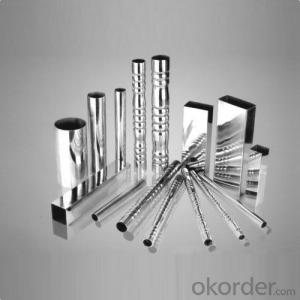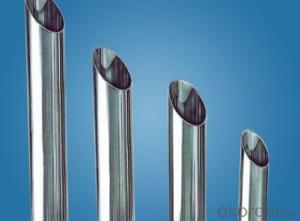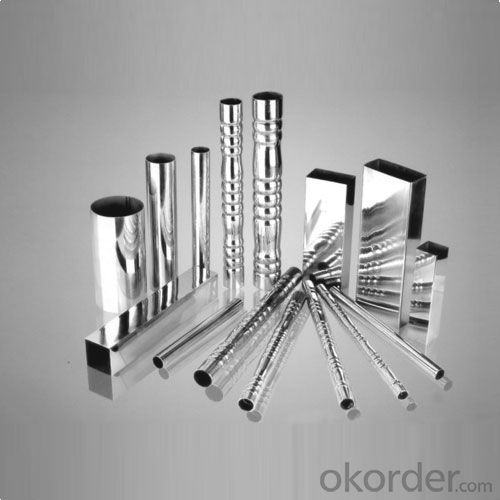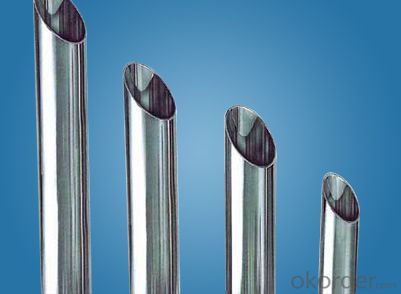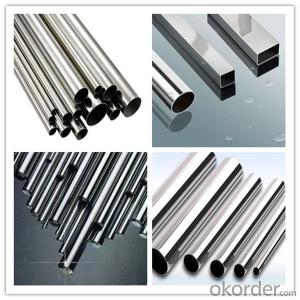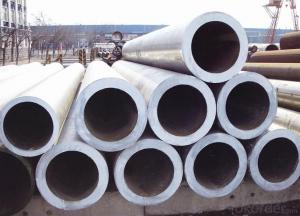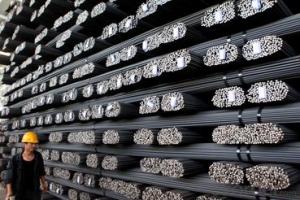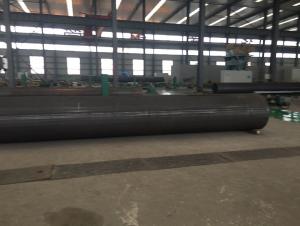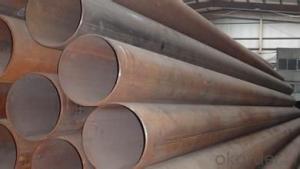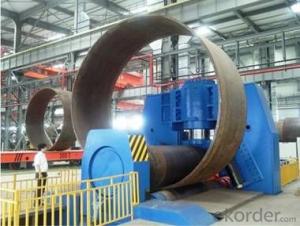Large Diameter Stainless Steel Pipe for Wholesales
- Loading Port:
- Tianjin
- Payment Terms:
- TT OR LC
- Min Order Qty:
- 35 m.t.
- Supply Capability:
- 3000 m.t./month
OKorder Service Pledge
OKorder Financial Service
You Might Also Like
Specification
Large Diameter Stainless Steel Pipe for Wholesales
1.Structure of Stainless Steel Pipe :
Stainless steel pipe is formed by drawing a solid billet over a piercing rod to create the hollow shell. As the manufacturing process does not include any welding, seamless pipes are perceived to be stronger and more reliable. Historically seamless pipe was regarded as withstanding pressure better than other types, and was often more easily available than welded pipe.
2.Main Features of the Stainless Steel Pipe :
• High manufacturing accuracy
• High strength
• Small inertia resistance
• Strong heat dissipation ability
• Good visual effect
• Reasonable price
3.Stainless Steel Pipe Specification:
Standard | GB, DIN, ASTM ASTM A106-2006, ASTM A53-2007 |
Grade | 10#-45#, 16Mn 10#, 20#, 45#, 16Mn |
Thickness | 8 - 33 mm |
Section Shape | Round |
Outer Diameter | 133 - 219 mm |
Place of Origin | Shandong, China (Mainland) |
Secondary Or Not | Non-secondary |
Application | Hydraulic Pipe |
Technique | Cold Drawn |
Certification | API |
Surface Treatment | factory state or painted black |
Special Pipe | API Pipe |
Alloy Or Not | Non-alloy |
Length | 5-12M |
Outer Diameter | 21.3-610mm |
Grade | 20#, 45#, Q345, API J55, API K55, API L80, API N80, API P110, A53B |
Standard | ASME, ASTM |
1) Material:20#(ASTM A 106/A53 GRB.API5LGRB,GB),45#,16Mn,10#.
2) Specification range:OD:21.3-610mm,WT:6-70mm,length:6-12m or according to the requirement of clients.
3) Excutive standards:GB,ASME API5L.ASTM A 106/A53,Despite of the above standards,we can also supply seamless steel pipe with standard of DIN,JIS,and so on,and also develop new products according to the requirements of our clients!
4) Surface:black lacquered,varnish coating or galvanized.
5) Ends:Beveled or square cut,plastic capped,painted.
6) Packing:bundles wrapped with strong steel strip,seaworthy packing.
4. Application of Stainless Steel Pipe
Stainless steel pipe is used for structural and piping applications that require the properties that stainless steel delivers – high strength, toughness and excellent corrosion resistance. The pipe is available in sizes 1/2" through 36” in outside diameter (OD) and schedules 05S through 80S and larger for wall thickness (WT). It is available as welded and seamless. Stainless pipe has a dull gray, mill finish.
5.Packaging & Delivery of Stainless Steel Pipe
Packaging Details: | seaworthy package,bundles wrapped with strong steel strip |
Delivery Detail: | 50-60days after received 30%TT or Original LC |
6.FAQ of Stainless Steel Pipe :
A. How is the quality of your products?
Our products are manufactured strictly according to national and internaional standard, and we take a test on every pipe before delivered out. If you want see our quality certifications and all kinds of testing report, please just ask us for it.
Guaranteed: If products’ quality don’t accord to discription as we give or the promise before you place order, we promise 100% refund.
B.How about price?
Yes, we are factory and be able to give you lowest price below market one, and we have a policy that “ for saving time and absolutely honest business attitude, we quote as lowest as possible for any customer, and discount can be given according to quantity”,if you like bargain and factory price is not low enough as you think, just don’t waste your time.Please trust the quotation we would give you, it is professional one.
C.
Why should you chose us?
Chose happens because of quality, then price, We can give you both.Additionally, we can also offer professional products inquiry, products knowledge train(for agents), smooth goods delivery, exellent customer solution proposals.Our service formula: good quality+good price+good service=customer’s trust
SGS test is available, customer inspection before shipping is welcome, third party inspection is no problem.
Any question, pls feel free to contact us !
7. Stainless Steel Pipe Images:

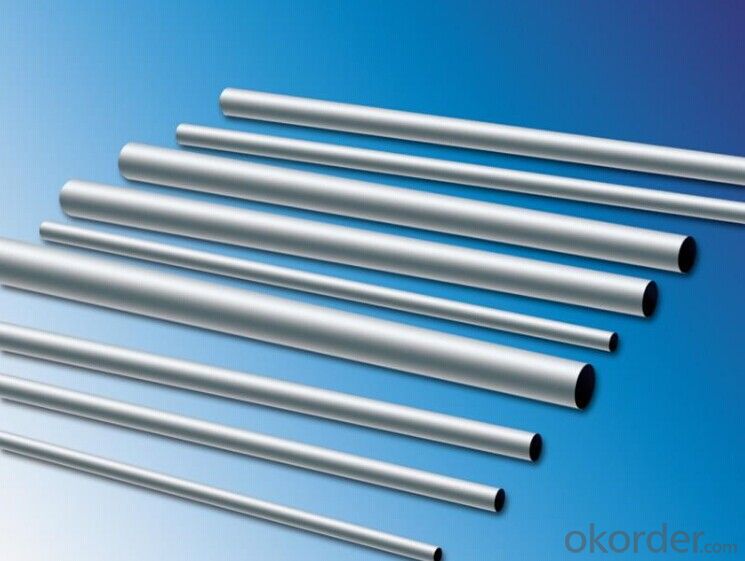
8. Company Information:
CNBM International Corporation (CNBM International) is the most important trading platform of CNBM Group Corporation, a state-owned company under the direct supervision of State-owned Assets Supervision and Administration Commission of the State Council.
Since 2004, the trading volume of CNBM International has been doubled in 5 successive years owing to the support of superior corporations and effort of all staff. Meanwhile, we have established strategic partnerships with hundreds of domestic manufacturers and sound business relations with clients from over 120 countries. Currently, we have wholly-owned overseas subsidiaries and branches in 5 countries with a view to realize localization, which also represents an essential progress in our globalization target.
In line with the business, CNBM International launched E-business platform Okorder.com.Our goal is to transform CNBM International into the global leading brand in building materials industry within 3 to 5 years through innovation and reform, by strengthening the overall management of supply chain, developing and cultivating both domestic and overseas market, improving the procedure and information system, enhancing the ability to organize resources and to provide value-added services under a professional team and a learning organization.
- Q: What is stainless steel pipe?
- Stainless steel pipe is a type of pipe made from an alloy of steel and chromium, which provides excellent resistance to corrosion and oxidation. It is commonly used in various industries, including construction, automotive, and manufacturing, due to its durability, strength, and aesthetic appeal. Stainless steel pipes are known for their ability to withstand high temperatures and pressure, making them suitable for applications that involve transporting fluids and gases. Additionally, they are available in various sizes, shapes, and grades to meet specific requirements. Whether in residential or industrial settings, stainless steel pipes are widely used for plumbing, water supply systems, HVAC systems, and many other applications where durability and corrosion resistance are essential.
- Q: Can stainless steel pipes be used for solar power plants?
- Yes, stainless steel pipes can be used for solar power plants. Stainless steel is highly resistant to corrosion and can withstand the harsh environmental conditions typically found in solar power plants. It offers excellent durability and longevity, making it a suitable choice for transporting various fluids and gases in the solar power plant infrastructure.
- Q: Are stainless steel pipes suitable for food storage tanks?
- Yes, stainless steel pipes are suitable for food storage tanks. Stainless steel is highly resistant to corrosion, easy to clean, and does not impart any taste or odor to food products. It is a preferred material in the food and beverage industry due to its hygienic properties and ability to maintain the quality and safety of stored food.
- Q: What is the difference between seamless and HFW stainless steel pipes?
- Seamless stainless steel pipes are made by piercing a solid billet of stainless steel and then rolling it into a pipe shape without any welding or joints. This seamless manufacturing process results in a smooth and continuous pipe with uniform thickness throughout. On the other hand, HFW (High-Frequency Welding) stainless steel pipes are created by forming a flat strip of stainless steel into a pipe shape and then welding the edges using high-frequency electric currents. This welding process produces a strong and durable joint, but there may be a noticeable weld bead or seam along the length of the pipe. In summary, the main difference between seamless and HFW stainless steel pipes lies in their manufacturing processes. Seamless pipes have no welds or joints, offering a smooth appearance and enhanced corrosion resistance. HFW pipes, although having welded seams, provide a cost-effective option with reliable strength and durability. Ultimately, the choice between these two types of pipes depends on specific application requirements and budget considerations.
- Q: What is the difference between 409 and 316 stainless steel pipes?
- The main difference between 409 and 316 stainless steel pipes lies in their composition and intended use. 409 stainless steel is a ferritic stainless steel, meaning it contains a higher amount of chromium but lower amounts of nickel compared to 316 stainless steel. This makes 409 stainless steel less resistant to corrosion and oxidation, but it is still suitable for applications that involve moderate levels of corrosion resistance, such as automotive exhaust systems and heat exchangers. On the other hand, 316 stainless steel is an austenitic stainless steel that contains higher amounts of both chromium and nickel. Due to its composition, it offers excellent corrosion resistance, even in harsh environments, and is often used in applications where superior resistance to corrosion is required, such as marine environments, chemical processing plants, and medical equipment. In summary, the key differences between 409 and 316 stainless steel pipes are their composition and corrosion resistance. 409 stainless steel is suitable for applications with moderate levels of corrosion resistance, while 316 stainless steel is preferred for applications that require superior corrosion resistance in harsh environments.
- Q: What are the different types of stainless steel pipe end connections?
- There are several different types of stainless steel pipe end connections, each designed for specific applications and requirements. Some of the most common types include: 1. Threaded connections: This type of connection features threads on the inside or outside of the pipe end, allowing it to be screwed onto another threaded fitting or pipe. Threaded connections are typically used for low-pressure applications. 2. Socket-weld connections: In this type of connection, the pipe end is inserted into a socket or recess of a socket-weld fitting and then welded around the outside of the pipe. Socket-weld connections are suitable for high-pressure applications and are known for their strength and reliability. 3. Butt-weld connections: Butt-weld connections involve welding the pipe end directly to another pipe or fitting. They are commonly used in high-pressure and high-temperature applications. 4. Flanged connections: Flanged connections feature a flange on the pipe end, which is then bolted to a mating flange on another pipe or fitting. Flanged connections are used in applications requiring easy disassembly or where there is a need for frequent maintenance. 5. Compression connections: Compression connections involve using a compression fitting to join the pipe ends. These connections are commonly used in plumbing and gas supply systems and are known for their ease of installation. 6. Grooved connections: Grooved connections involve using grooved couplings to join the pipe ends. These connections are often used in fire protection systems and are known for their quick and simple installation. Overall, the choice of stainless steel pipe end connection depends on the specific application, pressure requirements, ease of installation, and maintenance considerations. It is important to consult with a professional or refer to industry standards to determine the most suitable connection type for your particular needs.
- Q: Can stainless steel pipes be used for nuclear waste storage?
- Stainless steel pipes can indeed be used for nuclear waste storage. Stainless steel is highly resistant to corrosion, making it an ideal material for containing and transporting hazardous materials such as nuclear waste. The properties of stainless steel, including its durability, strength, and ability to withstand extreme temperatures, make it suitable for long-term storage of radioactive waste. Additionally, stainless steel is non-reactive and does not leach out harmful substances, ensuring the integrity of the stored waste. It is important, however, to ensure that the stainless steel used meets the specific requirements and standards set for nuclear waste storage to ensure maximum safety and containment.
- Q: 304 stainless steel pipe, 20*2 pressure, how many kilograms?
- 304 is a versatile stainless steel which is widely used in the manufacture of equipment and parts requiring good overall performance (corrosion resistance and formability).
- Q: Are stainless steel pipes resistant to pitting and crevice corrosion?
- Yes, stainless steel pipes are highly resistant to pitting and crevice corrosion. This is due to the presence of a protective layer of chromium oxide on the surface of the steel, which forms a barrier against corrosive elements. This layer is self-healing, meaning that even if it gets damaged, it will regenerate quickly, ensuring continued corrosion resistance. Stainless steel pipes are commonly used in various industries that deal with corrosive substances, such as the chemical, oil and gas, and food processing industries, where the pipes are exposed to aggressive environments. Overall, stainless steel pipes are a reliable choice for applications where corrosion resistance is a critical requirement.
- Q: What is the difference between nominal size and actual size in stainless steel pipes?
- The difference between nominal size and actual size in stainless steel pipes lies in how they are measured and labeled. Nominal size refers to the designation given to a pipe based on its approximate dimensions, typically in inches or millimeters. This designation is used for easy identification and standardization purposes. On the other hand, actual size refers to the precise measurements of the pipe, such as its outer diameter (OD) and wall thickness. These measurements are usually expressed in fractions of an inch or in millimeters. The actual size is crucial for determining the pipe's compatibility with fittings, valves, and other components, as well as for calculating flow rates and pressure ratings. It is important to note that the nominal size of a stainless steel pipe may not necessarily match its actual size. This discrepancy is due to historical reasons and manufacturing practices. In some cases, the nominal size is slightly larger or smaller than the actual size to accommodate variations in wall thickness or to align with industry standards. Therefore, when selecting stainless steel pipes, it is essential to consider both the nominal size and the actual size to ensure proper fitment and functionality. Consulting the manufacturer's specifications or seeking professional advice can help in determining the appropriate pipe size for a given application.
Send your message to us
Large Diameter Stainless Steel Pipe for Wholesales
- Loading Port:
- Tianjin
- Payment Terms:
- TT OR LC
- Min Order Qty:
- 35 m.t.
- Supply Capability:
- 3000 m.t./month
OKorder Service Pledge
OKorder Financial Service
Similar products
Hot products
Hot Searches
Related keywords
